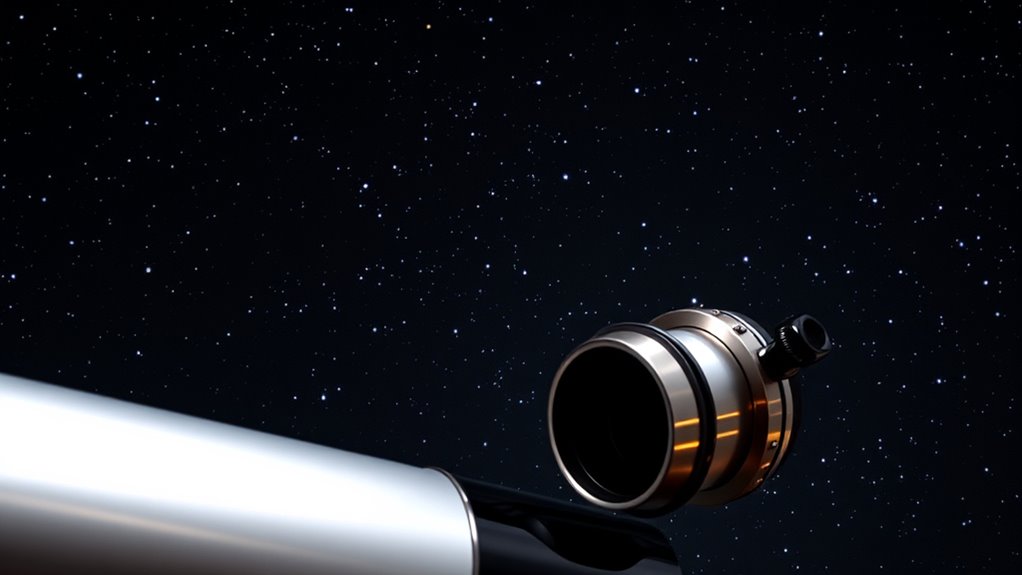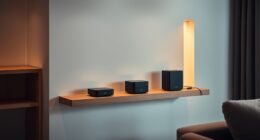If you’re looking for the best 130mm triplet APO refractors for astrophotography, I’ve got you covered with top options like the Explore Scientific ED102, SVBONY SV550, and Askar 120APO. These scopes combine excellent optical quality, portability, and compatibility with various accessories. They’re perfect for capturing detailed planetary and deep-sky images. Keep exploring to discover detailed comparisons and what makes each model stand out for stellar imaging.
Key Takeaways
- Look for models with high-quality apochromatic triplet optics and ED glass to minimize chromatic aberration and ensure sharp, color-accurate images.
- Prioritize lightweight, portable designs with sturdy mounts and accessories like dovetails for versatile astrophotography setups.
- Choose scopes with full-frame compatible field flatteners and advanced coatings (StarBright XLT, FCD100) for edge-to-edge clarity.
- Consider imaging features such as high-resolution sensors, fast frame rates, and compatibility with T-adapters for planetary and deep-sky imaging.
- Evaluate support, build quality, and accessory options to ensure long-term reliability and expandability for diverse astrophotography applications.
SVBONY SV550 Triplet APO Telescope
If you’re looking for a highly portable yet powerful triplet APO refractor for astrophotography, the SVBONY SV550 stands out as an excellent choice. With a 122mm aperture and F7 focal ratio, it captures plenty of light while remaining compact at just over 14 pounds. Its FPL-51 triplet with ED glass ensures minimal chromatic aberration, delivering crisp, detailed images of deep-sky objects and planets. The dual-speed 2.5-inch focuser offers precise control, and its sturdy build with high-quality finish rivals premium brands. Lightweight and easy to to carry, it’s perfect for on-the-go astrophotographers seeking top-tier performance without breaking the bank.
Best For: amateur astronomers and astrophotographers seeking a portable, high-quality APO refractor for deep-sky imaging and planetary observation.
Pros:
- Excellent optical performance with minimal chromatic aberration thanks to FPL-51 triplet design.
- Lightweight and compact, making it highly portable for travel and on-the-go astrophotography.
- Robust dual-speed focuser and high-quality build quality comparable to premium brands.
Cons:
- Some users may experience minor issues like dirt between lens elements or support challenges.
- Slightly higher price point compared to entry-level refractors, though still affordable relative to premium models.
- Assembly and handling require careful attention to avoid damage or misalignment during setup.
Explore Scientific ED102 Triplet Refractor Telescope
The Explore Scientific ED102 Triplet Refractor Telescope stands out as an excellent choice for astrophotographers seeking sharp, high-contrast images with minimal chromatic aberration. Its FCD1 HOYA ED glass and multi-layer coatings deliver stunning detail across lunar, planetary, and deep-sky objects. The air-spaced triplet design guarantees edge-to-edge sharpness, while its versatile 714mm focal length and f/7 ratio suit both visual and astrophotography needs. Weighing just 12 pounds, it’s portable and easy to set up, especially with its collimation system and retractable dew shield. Minor issues like focuser backlash are easily managed, making this scope a reliable, value-packed option for enthusiasts.
Best For: amateur astronomers and astrophotographers seeking a portable, high-quality apochromatic refractor for detailed lunar, planetary, and deep-sky imaging.
Pros:
- Virtually eliminates chromatic aberration for sharp, color-rich images
- Lightweight and portable at only 12 pounds, ideal for travel and quick setup
- High-contrast optical performance with minimal aberrations and edge-to-edge sharpness
Cons:
- Slight focuser backlash and minor imperfections in focus adjustment
- Mounting method can cause star shape distortions in some setups
- Additional accessories like flatteners and spacers are often needed for optimal astrophotography results
Explore Scientific ED80 Triplet Refractor Telescope
Designed for astrophotographers who demand high optical performance in a portable package, the Explore Scientific ED80 Triplet Refractor Telescope offers exceptional image clarity and color correction. Its FCD1 HOYA ED glass and multi-layer coatings deliver high-contrast, detailed views of the Moon, planets, nebulae, and star clusters. Perfect for astrophotography, the f/6 focal ratio captures vibrant, high-quality images of bright deep-sky objects. Its compact 480mm focal length and retractable dew shield make it easy to carry and set up. With precise push-pull collimation adjustments, it ensures sharp, pinpoint stars. Support from Explore Scientific guarantees reliable assistance for a smooth imaging experience.
Best For: amateur and advanced astrophotographers seeking a portable, high-performance refractor telescope for capturing detailed images of deep-sky objects and planets.
Pros:
- Exceptional optical quality with genuine FCD1 HOYA ED glass and multi-layer coatings for high contrast and sharp images
- Compact and lightweight design with a 480mm focal length, making it highly portable and easy to set up
- Precise push-pull collimation adjustments ensure optimal alignment and pinpoint star images
Cons:
- Limited aperture size of 80mm may restrict the brightness of very faint deep-sky objects compared to larger telescopes
- Requires additional accessories, such as mounting and camera adapters, for astrophotography use
- As a specialized refractor, it may be more expensive than comparable beginner-level telescopes
Explore Scientific FCD100 Series 80mm Apochromatic Refractor Telescope
For amateur astronomers seeking a portable yet high-performance refractor, the Explore Scientific FCD100 Series 80mm Apochromatic Refractor Telescope stands out. Its optical quality is exceptional, featuring genuine Hoya FCD100 ED glass and multi-layer coatings that deliver sharp, high-contrast images free of chromatic aberrations. The air-spaced triplet design ensures color accuracy and detailed views, making it ideal for astrophotography of the Moon, planets, nebulae, and galaxies. Its compact form, with an 80mm aperture and 480mm focal length, provides excellent light-gathering power while remaining lightweight and easy to transport. Additional features like the dual-speed focuser and included dew shield enhance usability.
Best For: amateur astronomers seeking a portable, high-quality apochromatic refractor ideal for astrophotography and visual observation.
Pros:
- Exceptional optical quality with genuine Hoya FCD100 ED glass and multi-layer coatings for sharp, color-accurate images
- Air-spaced triplet design virtually eliminates chromatic aberrations, ensuring high-contrast views
- Compact and lightweight, making it highly portable and easy to set up for spontaneous stargazing
Cons:
- Slightly higher price point compared to beginner-grade refractors
- Limited aperture size may restrict deep-sky object detail for advanced astrophotographers
- Requires additional accessories (like mounts) for optimal use, which can increase overall setup cost
Celestron StarSense Explorer DX 130AZ Telescope
If you’re a beginner seeking an easy-to-use telescope with advanced guidance technology, the Celestron StarSense Explorer DX 130AZ stands out. It’s a 130mm Newtonian reflector with a manual altazimuth mount, dual slow-motion controls, and an adjustable tripod. Included are two eyepieces—10mm and 25mm—giving 65x and 26x magnification, perfect for lunar and planetary viewing, as well as deep-sky objects like Orion Nebula and Andromeda. Its smartphone app uses sky recognition technology to guide you effortlessly to celestial targets, making object location intuitive. Assembly takes about 30 minutes, and the telescope’s optical quality delivers bright, sharp views even in light-polluted areas.
Best For: beginners and amateur astronomers seeking an easy-to-use telescope with advanced smartphone-guided object locating technology.
Pros:
- User-friendly assembly and operation, ideal for newcomers
- Accurate sky recognition technology that simplifies object locating
- Bright, detailed views of the Moon, planets, and deep-sky objects with high optical quality
Cons:
- Manual altazimuth mount requires some effort to track objects for extended viewing
- Sunken Allen screws on slow-motion controls may be less intuitive than thumb screws
- Limited to two eyepieces, which might restrict magnification options for advanced users
Explore Scientific FCD100 Series ED102 Apochromatic Refractor Telescope
The Explore Scientific FCD100 Series ED102 Apochromatic Refractor Telescope stands out as an excellent choice for serious astrophotographers seeking high image clarity. Its 102mm aperture and 714mm focal length deliver sharp, detailed images across planetary and deep-sky targets. The use of genuine HOYA FCD100 ED glass and multi-layer coatings effectively correct chromatic aberration, ensuring crisp, color-accurate views. Weighing just under 11 pounds and featuring an air-spaced aluminum construction, it’s durable yet portable. Its OTA-only design offers compatibility with various mounts, making it versatile for both astrophotography and visual observation. Highly rated, it’s a reliable, high-performance refractor for stellar imaging.
Best For: serious astrophotographers and amateur astronomers seeking high-precision, portable refractor telescopes for planetary and deep-sky imaging.
Pros:
- Exceptional chromatic aberration correction with genuine HOYA FCD100 ED glass and multi-layer coatings
- Lightweight and durable air-spaced aluminum construction for portability and stability
- Versatile OTA-only design compatible with various mounts for both astrophotography and visual use
Cons:
- Higher price point compared to entry-level telescopes
- Limited to 102mm aperture, which may be less suitable for very faint deep-sky objects for some users
- Requires additional accessories and mounts for complete setup and optimal performance
SVBONY SV105 Telescope Camera for Astrophotography
Looking to dip your toes into astrophotography without investing in complex equipment? The SVBONY SV105 Telescope Camera is perfect for beginners. It captures lunar, planetary, and terrestrial images easily, thanks to its user-friendly design. Equipped with a 1/2.8-inch IMX307 CMOS sensor, it records up to 30 fps at 1080p and supports high-speed 2K video. Its dark light compensation improves clarity in low-light conditions. Connecting via USB for plug-and-play use, it’s compatible with Windows, Linux, and Android. This camera acts as an electronic eyepiece, making real-time celestial observation simple and accessible for newcomers enthusiastic to start their astrophotography journey.
Best For: beginners and entry-level astrophotography enthusiasts looking for an easy-to-use, plug-and-play camera for lunar, planetary, and terrestrial imaging.
Pros:
- User-friendly design suitable for beginners with no prior experience required
- High-quality 1/2.8-inch CMOS sensor capturing up to 30 fps at 1080p resolution
- Compatible with Windows, Linux, and Android devices for versatile use
Cons:
- Not compatible with iOS devices like phones and tablets
- Limited to 1080p resolution at 30 fps, which may not meet advanced astrophotography needs
- Requires additional software (Sharpcap, AstroDMx) for full functionality on certain platforms
Celestron Omni XLT 120 Refractor Telescope
For amateur astronomers seeking a reliable and high-quality refractor, the Celestron Omni XLT 120 stands out thanks to its exceptional optical performance and solid mechanical design. Its hand-selected optical tube uses premium glass and is fully multi-coated with StarBright XLT coatings, ensuring maximum light transmission for bright, sharp images. The sturdy CG-4 German equatorial mount offers smooth, precise tracking, making it ideal for both observing and astrophotography. It comes with essential accessories like a finderscope, steel tripod, star diagonal, and eyepiece, plus free SkyNight software. Overall, this telescope balances quality and ease of use, making it a great choice for enthusiasts at any level.
Best For: amateur astronomers of all skill levels seeking a reliable, high-quality refractor telescope for daytime and nighttime observing.
Pros:
- Exceptional optical quality with fully multi-coated StarBright XLT coatings for bright, clear images
- Stable and precise CG-4 German equatorial mount with smooth tracking and manual control
- Comes with comprehensive accessories including finderscope, steel tripod, star diagonal, and eyepiece, plus free software
Cons:
- Manual mount requires some adjustment and may be less suitable for astrophotography without additional upgrades
- Slightly heavier and bulkier due to the steel tripod, which may impact portability
- Limited to visual observing unless paired with specialized astrophotography equipment
SVBONY SV550 Telescope with Field Flattener for Astrophotography
If you’re seeking a lightweight yet highly precise telescope for deep sky astrophotography, the SVBONY SV550 stands out with its advanced optical design and thoughtful features. This 80mm F6 APO triplet refractor offers excellent image quality, thanks to multiple internal light barriers that minimize light pollution and maximize contrast. The included SV209 field flattener guarantees a flat field suitable for full-frame cameras, maintaining sharpness across the entire image. Its magnesium alloy focusing seat reduces weight for portability, while the 180mm dovetail mount provides stability and versatility. Overall, the SVBONY SV550 delivers professional-level performance in a compact, user-friendly package ideal for astrophotographers.
Best For: amateur and professional astrophotographers seeking a lightweight, high-precision telescope optimized for deep sky imaging with full-frame or half-frame cameras.
Pros:
- Advanced optical design with multiple internal light barriers for enhanced contrast and minimal light pollution
- Includes SV209 field flattener ensuring a flat, sharp field suitable for full-frame astrophotography
- Lightweight magnesium alloy focusing seat and stable 180mm dovetail mount improve portability and setup stability
Cons:
- Limited aperture size may restrict the brightness of very faint deep sky objects
- Requires additional accessories (e.g., mounting, camera adapters) for full astrophotography setup
- Slightly higher cost compared to entry-level refractors with simpler optical configurations
Askar 120APO Telescope for Astrophotography and Viewing
The Askar 120APO Telescope stands out as an excellent choice for astrophotographers seeking high-quality, portable optics. Its 120mm aperture and F7 focal ratio deliver sharp, detailed images with minimal chromatic aberration thanks to the triplet air-spaced design and ED glass element. Weighing just 5.7kg and measuring up to 804mm, it’s easy to transport and set up for both imaging and visual observation. The included accessories, like tube rings, a handle, and a Vixen dovetail plate, enhance convenience. With its compact size and advanced optics, the Askar 120APO is perfect for those wanting stellar performance without sacrificing portability.
Best For: astrophotographers and amateur astronomers seeking a portable, high-quality APO refractor for detailed imaging and viewing.
Pros:
- High-quality triplet air-spaced optical design with ED glass for excellent color correction and sharp images
- Lightweight and compact, making it highly portable and easy to transport and set up
- Comes with essential accessories like tube rings, handle, and dovetail plate for convenient mounting and operation
Cons:
- Slightly heavier than some comparable portable refractors, which may affect ease of handling for some users
- Fixed focal length of 840mm may limit versatility for wide-field or deep-sky imaging without additional accessories
- Price point might be higher compared to entry-level refractors, potentially limiting options for budget-conscious buyers
Explore Scientific FCD100 Series 127mm f/7.5 Carbon Fiber Triplet ED APO Refractor Telescope
The Explore Scientific FCD100 Series 127mm f/7.5 Carbon Fiber Triplet ED APO Refractor stands out with its lightweight, durable construction and high-quality ED optics, making it an excellent choice for astrophotographers who need a portable yet precise instrument. Its 952mm focal length and f/7.5 ratio deliver sharp, detailed images with a 0.9 arcsec resolution and a 13-magnitude limit. Although some users find the focuser and accessories lacking, the carbon fiber build keeps the weight at just 14 pounds, ideal for travel. Despite mixed reviews, it remains popular among those seeking a balance between portability and optical performance.
Best For: astrophotographers and amateur astronomers seeking a lightweight, portable, and high-quality ED apochromatic refractor for detailed celestial observation and imaging.
Pros:
- Constructed with durable carbon fiber for lightweight portability and resilience
- ED optics reduce chromatic aberration, delivering sharp, high-contrast images
- Compact design with a 952mm focal length suitable for travel and field use
Cons:
- Customer reviews indicate issues with the focuser and accessories, which may impact usability
- Perceived as overpriced relative to its build quality and performance compared to competitors
- Poor customer service and warranty support have been reported, affecting post-purchase experience
Factors to Consider When Choosing 130MM Triplet APO Refractors for Astrophotography

When choosing a 130mm triplet APO refractor for astrophotography, I focus on several key factors that impact performance and ease of use. Optical quality and correction are vital for sharp, clear images, while portability helps if I need to transport my setup. Additionally, I consider focuser stability, compatibility with accessories, and overall value to make certain I get the best results for my investment.
Optical Quality and Correction
Optical quality and correction are essential factors to contemplate when selecting a 130mm triplet APO refractor for astrophotography, as they directly impact image sharpness and color accuracy. High-quality models use ED or FCD glass elements that virtually eliminate chromatic aberration, resulting in crisp, true-color images. The air-spaced triplet design enhances optical correction by maintaining precise alignment and reducing distortions across the entire field of view. Multi-layer coatings on the lenses boost light transmission and contrast, delivering brighter, more detailed images. Superior correction minimizes edge distortion and ensures uniform sharpness from center to periphery, which is critical for capturing high-quality astrophotos. Additionally, proper collimation and focus mechanisms are vital to maintaining optical integrity and achieving optimal image clarity.
Portability and Ease of Use
Choosing a portable 130mm triplet APO refractor means considering how easy it is to transport, set up, and operate in the field. These refractors typically weigh between 10 to 14 pounds, making them manageable for travel and quick setups. Compact designs with shorter focal lengths and retractable dew shields improve handling and storage, perfect for fieldwork. Lightweight materials like magnesium alloy or carbon fiber help reduce weight without sacrificing stability. Simplified mounting options, such as standard dovetail plates and stable tripods, enable fast assembly and precise alignment. Features like smooth, dual-speed focusers and minimal accessory requirements make fine-tuning easier during imaging sessions. All these factors contribute to a more convenient, enjoyable astrophotography experience in the field.
Focuser Precision and Stability
A precise and stable focuser is indispensable for capturing sharp astrophotos, especially at high magnifications. I look for a dual-speed, 2.5-inch or larger focuser with smooth, accurate movement for fine adjustments. Minimal backlash and backlash compensation are critical to prevent focus shifts during imaging. A robust focuser with a locking mechanism helps keep focus stable when using heavy cameras or accessories. The construction should be durable, preferably metal like brass or stainless steel, to ensure long-term stability. Additionally, integrated collimation features allow for precise alignment of the optical elements, which is crucial for achieving maximum image sharpness. Overall, a high-quality focuser ensures precise focusing, minimizes vibrations, and maintains stability throughout your astrophotography session.
Compatibility With Accessories
Ensuring compatibility with accessories is essential when selecting a 130mm triplet APO refractor for astrophotography, as it directly impacts your ability to capture high-quality images. I look for a standard T-ring and T-adapter compatibility, which allows me to connect various cameras easily. A focus travel of at least 87mm is critical to accommodate back focus and flatteners for prime focus imaging. I also verify support for extension tubes and flat field correctors to guarantee sharp, edge-to-edge images on full-frame sensors. The focuser’s load capacity and smooth operation are indispensable for handling heavy cameras and accessories without flexure. Finally, I check for mounting interfaces like Vixen or Losmandy dovetails to ensure secure, stable attachment to my mount.
Price and Support Options
When selecting a 130mm triplet APO refractor for astrophotography, it’s crucial to take into account the overall price, including accessories and future upgrades, to make sure it fits your budget. Don’t forget to evaluate the manufacturer’s warranty coverage and support services, as these can save you time and money if repairs, collimation, or alignment issues arise. Research the reputation of customer support—responsive and helpful service makes a big difference if technical problems occur. Check if the seller or manufacturer offers prompt assistance with troubleshooting, parts replacement, or warranty claims, especially for high-value equipment. Keep in mind that some brands may have limited or delayed support, which could affect your telescope’s longevity and your overall investment in a 130mm APO refractor.
Frequently Asked Questions
What Are the Maintenance Requirements for 130MM Triplet APO Refractors?
Maintaining my 130mm triplet apo refractor is pretty straightforward. I clean the lenses with a gentle brush or blower to remove dust, avoiding harsh chemicals. I regularly check for dew buildup and use a dew shield or heater if needed. Plus, I keep the mount and tripod tight and balanced to prevent any misalignment. Routine inspections help guarantee ideal imaging and keep my setup in top shape.
How Do Different Triplet Designs Impact Image Quality and Color Correction?
Different triplet designs markedly impact image quality and color correction. I’ve found that fully apochromatic triplets excel at minimizing chromatic aberration, resulting in sharper, more accurate images. Variations in lens element spacing and glass types influence how well colors are corrected; premium designs often provide better contrast and detail. Overall, choosing a well-designed triplet guarantees clearer, more vibrant astrophotos, especially when capturing fine details like nebulae and star clusters.
Can These Telescopes Be Used Effectively for Planetary Astrophotography?
Absolutely, these telescopes excel at planetary astrophotography—if you enjoy pixel-peeping and chasing tiny details. With their sharp optics and exceptional color correction, I find they reveal planetary features with stunning clarity. Sure, they’re not the fastest for deep-sky shots, but for close-up planetary imaging, these 130mm triplets are a joy. I’d say, if planets are your obsession, these refractors are a smart investment.
What Accessories Are Essential for Optimal Astrophotography Performance?
For ideal astrophotography, I recommend investing in a sturdy mount, a high-quality camera adapter, and a good off-axis guider. A remote shutter release helps reduce vibrations, while a dew shield keeps lenses clear. I also find that a field flattener or reducer improves image sharpness, and having extra batteries and power supplies ensures uninterrupted sessions. These accessories make a significant difference in capturing crisp, detailed images.
How Do Cooling Times Affect Imaging Sessions With Large Aperture Triplets?
Cooling times considerably impact my astrophotography sessions because large aperture triplets need to reach thermal equilibrium for sharp, clear images. When I don’t allow enough cooling time, I notice increased thermal currents and distortions, which compromise image quality. I usually give my scope at least an hour to cool down before shooting, ensuring stable temperatures and minimizing heat plumes that could ruin my astrophotos.
Conclusion
Choosing the right 130mm triplet APO refractor is like finding the perfect brush for a masterpiece—essential for capturing the universe’s true colors. Each telescope on this list offers unique strengths, so think about your specific needs and passion. Remember, the right instrument can turn your astrophotography dreams into vivid reality, revealing celestial wonders that remind us how small yet extraordinary we are in this vast cosmos. Happy stargazing!






















